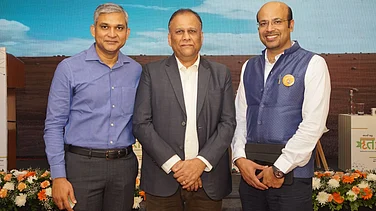MovingTech, the parent of Namma Yatri, has launched lifetime zero-commission cab rides in Delhi-NCR under the brand ‘Yatri’. Prior to this launch, the company conducted a successful pilot with autorickshaws.
In a zero commission model, no commission fee is charged. Instead, a one-time fee or subscription fee applies. Cab aggregators generally charge a commission fee of around 20 to 40 percent.
A part of the government-backed ONDC network, Yatri is an open and community-driven app for cabs and autos. Yatri, supported by the government-backed ONDC network, is a community-driven app for cabs and autorickshaws.
Additionally, in April this year, Namma Yatri launched a lifetime zero commission model in Bengaluru for cab drivers. The cab drivers won't have to pay anything till October. After that, a subscription fee of Rs 90 will be charged from them every day. This fee will be there irrespective of the number of rides.
Zero Commission Model Designed to Empower Drivers says Namma Yatri's Shan MS
In the ride hailing space, Namma Yatri came up with the zero-commission model. The company claims that they came up with the model to create a fair and transparent ecosystem for riders.
“The zero Commission model is designed to empower drivers while ensuring affordability for customers,” says Shan MS, chief operating officer, Namma Yatri.
In an earlier interview with Outlook Business, Shan explained that existing platforms treat drivers as mere resources, causing dissatisfaction with their treatment and commission structures, which leads to poor customer service. To address these issues, they aimed to tackle the root cause by adopting a more empathetic, people-first approach.
Last year, the company introduced two subscription options for auto drivers: a daily fee of Rs 25 for unlimited rides or Rs 3.50 per trip for up to 10 trips, with any extra rides included at no additional cost.
After Namma Yatri, several other ride-hailing platforms started coming up with the zero commission model. Ride hailing platform Rapido in February 2024 highlighted that it is planning to make a shift from a commission-based model to a zero commission model.
With the zero-commission initiative, Rapido aims to bring many offline drivers onto its platform, according to Rapido Co-Founder Pavan Guntupalli. In April this year, Ola and Uber also introduced subscription-based plans for auto drivers.
In areas including Delhi-NCR, Mumbai, Bengaluru, and Hyderabad, Ola reportedly rolled out its subscription model for its auto drivers. Its rival Uber also launched the same model as per an Economic Times report in cities such as Chennai, Kochi, and Visakhapatnam.
Speaking about the model, an Uber spokesperson told the Economic Times that they want to give the optionality to its riders “since many companies are already operating on this model.”.
Business Model of the Zero Commission Model
With many platforms availing of the zero commission model, the question remains as to how they generate their revenue.
“Monetisation is a natural progression, and we have a driver subscription fee as a means to sustain and grow our platform. In the future, we will explore avenues like partnerships and value-added services to customers,” says Shan. He adds that the key is to remain sustainable in the long run.
Another leverage for Namma Yatri is that the company doesn’t have to pay the five percent GST under Section 9 (5) of the Central GST (CGST) Act, as per the Karnataka AAR. The Karnataka AAR reportedly ruled that merely connecting service providers with customers through a digital platform does not qualify as a supply or service, based on the interpretation of the word "through." The council stated that the supply is carried out independently of the applicant, who is only involved in identifying the service provider and has no responsibility for the operation or completion of the ride.
Speaking about the revenue model, Som Kapoor, partner automotive, EY Parthenon, highlights that it is important to focus on the evolving business of the model rather than just looking at the commission structure.
He adds, “I'm uncertain whether it's a zero-commission or reduced-commission model, as every business aims to generate revenue. A sustainable revenue model, whether through a fair commission structure, subscription fees, or another approach, will be necessary. Therefore, zero commission doesn't necessarily mean zero revenue.”
Kapoor further adds that using ONDC is something that helps companies save cost. “People have begun utilising protocol services from ONDC to develop this business model, thereby reducing the costs associated with the subscription fees previously charged by traditional platform providers,” he says.
Will There Be a Rise of Zero-Commission Model in the Future?
While it's visible that several companies are adopting the model, the question that arises is if this is a model that will be adopted by companies in the future as well.
Shan says, “While it’s too early to predict the widespread adoption of this model across the industry, we believe it has significant potential, especially in markets where drivers are looking for better earning opportunities and customers value cost-effective options.”
However, Shan mentions that factors such as market dynamics and the ability of the companies to develop this model are some of the factors that will determine the success of this model. “It's likely that a combination of traditional and zero-commission models will coexist as the industry evolves,” he adds.
The zero-commission model, however, is not confined only to the ride-hailing space. Several mutual fund platforms, discount brokerages, and e-commerce platforms are also using zero commission models. Meesho claims that it was the first e-commerce platform to come up with a zero commission model. In 2021, the platform introduced this model to encourage sellers to invest their capital more efficiently rather than spending a significant portion on commissions.
In a blog post, Vidit Aatrey, Co-Founder & CEO of Meesho, discussed the model, highlighting that their understanding of the challenges business owners face when transitioning from offline to online guided them in creating a platform that ensures ease of operations and product visibility. He expressed confidence that Meesho’s zero commission model will significantly help sellers realize how seamless and efficient the digital transition can be.
Speaking about the model, Shan says, “While this model challenges the status quo, it also presents unique opportunities to build trust and loyalty among drivers and customers.” It will be interesting to see how this model develops within the broader ride-hailing landscape.































